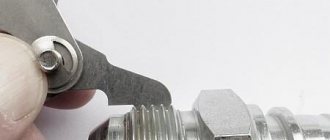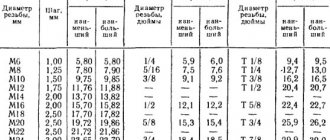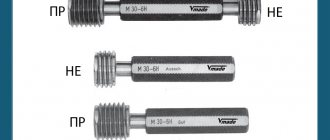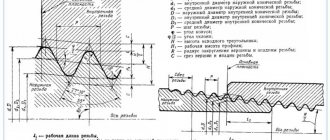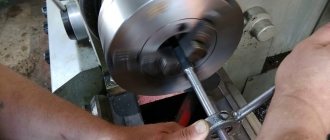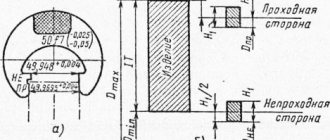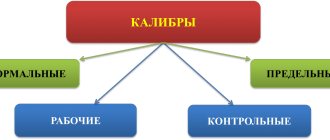INTERSTATE COUNCIL FOR STANDARDIZATION, METROLOGY AND CERTIFICATION (IGU)
INTERSTATE COUNCIL FOR STANDARDIZATION, METROLOGY AND CERTIFICATION (ISC)
| INTERSTATE STANDARD | GOST 24997-2004 (ISO 1502:1996) |
GAUGES FOR METRIC THREAD
Tolerances
ISO 1502:1996
ISO general-purpose metric screw threads - Gauges and gauging (MOD)
Moscow
Standardinform
2005
Preface
The goals, basic principles and basic procedure for carrying out work on interstate standardization are established by GOST 1.0-92 “Interstate standardization system. Basic provisions”, GOST 1.2-97 “Interstate standardization system. Interstate standards, rules and recommendations for interstate standardization. Procedure for development, adoption, application, updating and cancellation"
Standard information
1 DEVELOPED by the Open Joint-Stock Company “Research and Design Institute of Measuring Instruments in Mechanical Engineering” (JSC “NIIizmereniya”)
2 INTRODUCED by Gosstandart of Russia
3 ADOPTED by the Interstate Council for Standardization, Metrology and Certification (Protocol No. 25 of May 26, 2004)
The following voted for adoption:
| Short name of the country according to MK (ISO 3166) 004-97 | Country code according to MK (ISO 3166) 004-97 | Abbreviated name of the national standardization body |
| Azerbaijan | AZ | Azstandard |
| Armenia | A.M. | Armstandard |
| Belarus | BY | State Standard of the Republic of Belarus |
| Georgia | G.E. | Gruzstandart |
| Kazakhstan | KZ | Gosstandart of the Republic of Kazakhstan |
| Kyrgyzstan | KG | Kyrgyzstandard |
| Moldova | M.D. | Moldova-Standard |
| Russian Federation | RU | Gosstandart of Russia |
| Tajikistan | T.J. | Tajikstandard |
| Turkmenistan | TM | Main State Service "Turkmenstandartlary" |
| Uzbekistan | UZ | Uzstandard |
| Ukraine | U.A. | Gospotrebstandart of Ukraine |
4 This standard is modified from the international standard ISO 1502:1996 “ISO metric threads for general purposes. Calibers and measurements" (ISO 1502:1996 "ISO general-purpose metric screw threads - Gauges and gauging")
At the same time, additional provisions that take into account the needs of the national economy of the above states and the features of interstate standardization are highlighted in italics
5 By Order of the Federal Agency for Technical Regulation and Metrology dated March 2, 2005 No. 37-st, the interstate standard GOST 24997-2004 was put into effect directly as a national standard of the Russian Federation on July 1, 2005.
6 INSTEAD GOST 24997-81
Information on the entry into force (termination) of this standard is published in the “National Standards” index.
Information about changes to this standard is published in the “National Standards” index, and the text of these changes
- in
the information signs “National Standards”.
In case of revision or cancellation of this standard, the relevant information will be published in the information index “National Standards” GOST 24997-2004
(ISO 1502:1996)
INTERSTATE STANDARD
| GAUGES FOR METRIC THREAD Tolerances Gauges for metric thread. Tolerances |
Date of introduction - 2005-07-01
Key conditions for calibers
The basic requirements for all calibers are set out in the technical documentation for their manufacture. Such requirements are given in a wide variety of GOSTs. They can be divided into the following categories:
- competent choice of metal for the manufacture of measuring attachments (high rigidity must be ensured, which prevents the slightest deformation during storage and operation);
- the location of the working components (nozzles, plates, washers) must be done with a high degree of accuracy above the measured indicators;
- ensuring durability and wear resistance (this is ensured by the use of high-alloy tool steels and specialized alloys);
- high anti-corrosion resistance (use of specialized methods for processing calibers and resistant coatings);
- establishment of a periodic metrological control system (checks must be carried out in accordance with the established frequency and the results must be recorded in a suitable log);
- calibration of calibers must be done on equipment that has a very high accuracy class than the caliber itself;
- strict adherence to the established labeling system with precise indication of all the necessary indicators.
For example, the requirements for smooth plug gauges are set out in GOST 14810-69. This standard systematizes not only all requirements, but also defines all possible parameters of these measuring instruments.
How to use the tool
The rules for using such tools depend on their purpose. It is permitted to be used only in compliance with specific rules and the specified accuracy class established in the marking. The use of plug gauges to control the accuracy of manufactured holes is permitted only with the help of a tool close to the parameters of the hole itself. The key requirement for measurement accuracy is the free passage of the gauge insert through the hole being measured. Proper use of these devices requires compliance with the following rules:
- the passage side must enter the hole solely under the influence of its weight;
- It is not allowed to use additional methods of influencing the external environment (additional pressure, blows);
- Before checking, you need to clean the parts from dirt and mechanical processing residues;
- various types of lubricants that could affect the penetration of the caliber into the hole should be removed;
- the check must be performed without rotating the meter relative to the part being examined;
- compliance with the temperature regime is considered an indispensable requirement (parts should be checked exclusively at natural temperature);
- The frequency of inspections of the instrument itself and the rules for recording the results in established documents must be observed;
- each caliber must be stored in accordance with the established storage procedure (they should not come into contact with other metal parts and be exposed to the external environment).
To control external threads, it is enough to apply the tool itself to the threads and determine the degree of coincidence. Internal threads are examined by screwing a head into a finished threaded hole. The process should be easy without any problems or distortions.
A suitable smooth tool is used to check the surface of the tapered shaft. Quality is determined by the combination of the workpiece surface and the gauge surface. Comparison of the inner cone is performed by immersing the nozzle into the prepared hole.
Calibers perform timely monitoring of product performance of a considerable number of parts. This does not require specialized knowledge and the ability to use complex metrological instruments. The operation is completed quickly. However, several indicators can be compared.
Other types of calibers
The variety of problems that must be solved in the mass production of parts made by mechanical processing has required the creation of a wide range of measuring instruments. They must quickly and very accurately prove the class of the treated surface or compliance with technological standards. The classification of calibers is needed to clearly define the purpose of the measuring unit and the area of its use. The new production uses the following caliber options:
- plug gauges;
- staple-gauge;
- probes;
- cone-shaped calibers;
- for control of cut threads;
- precision surface treatment;
- profile templates;
- checking the relative position of the surface.
All types of smooth plugs for assessing the accuracy of cylindrical holes are made in accordance with GOST 24851-81. Standardization of these devices is specified in ISO-R1938-1971. This document approves the labeling and name of each class.
They are made one-sided and two-sided. In terms of measuring capabilities, they can be single-limit or double-limit. The first type is made of two options, passable and non-passable, any of them has the appropriate designation PR - passable and NOT - non-passable. For a control instrument, I add the letter K, for example, K-PR, which means control pass. The manufacturing option depends on the scale of production of important parts. If products are made in very small series, a sheet of alloy metal is used to make the tool; in large-scale production, casting or forging methods are used.
Using cone nozzles, the shape of cone-shaped surfaces is controlled. With their help, cone-shaped shanks, holes, and other gauges are checked. Devices for monitoring the mutual position of surfaces are quite diverse. They are made individually for each of the manufactured parts. With their help, the parallelism of nearby surfaces, the alignment of holes, and the symmetry of grooves placed on shafts or bushings are compared.
The size and shape of threaded products depends on the type and characteristics of the cut thread (its pitch, diameter and length). These instruments come in two varieties: regulated and non-regulated. The former have the ability to adjust some instrument parameters.
Profile structures include all types of templates that are designed to control the accuracy of an intricate surface shape. The key method for checking the finished product is considered to be the “light slit” method. It clearly shows that the manufactured shaped surface does not comply with the established requirements.
If you find an error, please select a piece of text and press Ctrl+Enter.
Design
The device of the plug gauge is regulated by the provisions of GOST 14807-69, GOST 24851-81, GOST 17758-72 and GOST 14810-69. These standards apply accordingly to:
- A smooth double-sided tool equipped with inserts with a diameter of 1...6 mm.
- A smooth double-sided tool, with inserts having a diameter of more than 3 (and up to 50 inclusive) mm.
- Threads of appropriate accuracy classes.
The plug gauge consists of:
- A handle that has the cross-sectional shape of a circle with a fairly wide flat, designed to securely hold the tool in the hand.
- Go-through measuring pin (with thread - for threaded gauge plugs).
- No-go measuring pin.
- Two locking inserts that hold the pins in place.
The plug gauge in accordance with GOST 14810-69 has a similar design, but for ease of holding, the surface of the handle is made with continuous corrugations. The handle can be designed in the form of a hexagon.
One of the ends of the measuring pin is made flat (near it there is a through groove into which the fixing insert fits). The second end has a chamfer, which makes it easier for the pin to enter the cavity being measured.
The symbol for plug gauges includes two groups of numbers with 4 characters in each group. The marking also indicates the size of the tolerance field that can be controlled using this plug gauge.
Handles are made of plastic (for tools with pins up to 3 mm) or metal. For the manufacture of pins, alloyed tool steels are used in accordance with GOST 5950-73, which are characterized by the smallest size fluctuations depending on external conditions of temperature and humidity.
Smooth plug gauges GOST 24851-81 are designed according to a similar principle, intended for estimating the dimensions of external surfaces, for example, shafts.
